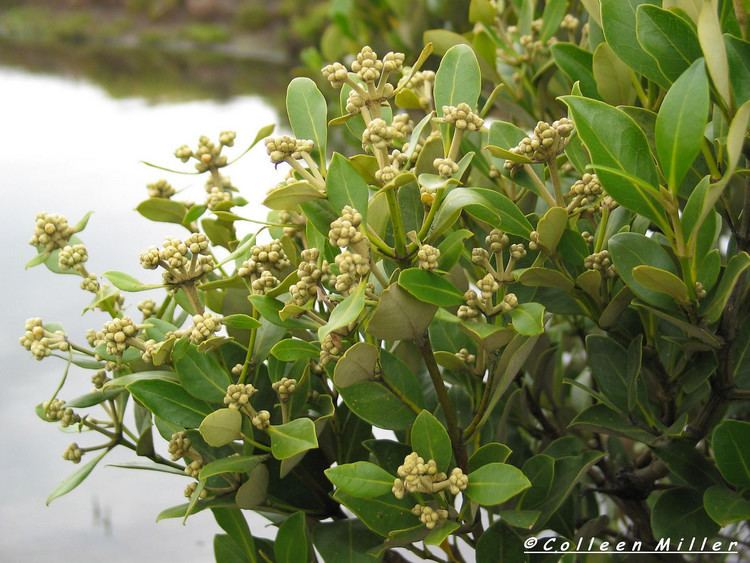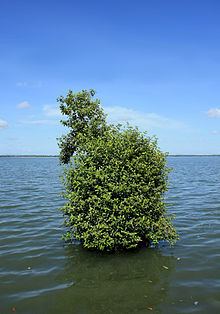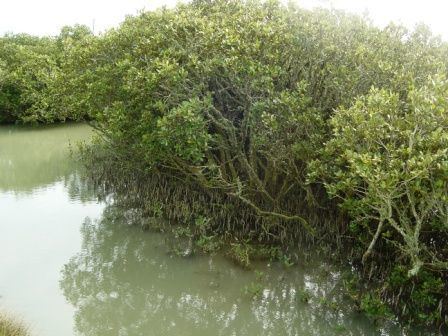Rank Species | Higher classification Avicennia | |
 | ||
Similar Avicennia, Rhizophora, Bruguiera, Sonneratia, Bruguiera gymnorrhiza | ||
Mangrove avicennia marina api api
Avicennia marina, commonly known as grey mangrove or white mangrove, is a species of mangrove tree classified in the plant family Acanthaceae (formerly in the Verbenaceae or Avicenniaceae). As with other mangroves, it occurs in the intertidal zones of estuarine areas.
Contents

Distribution

It is distributed along Africa's east coast, south-west, south and south-east Asia, and Australia. It occurs in New Zealand between 34 and 38 degrees south; its Māori name is mānawa. It is one of the few mangroves found in the arid regions of the coastal Arabian Peninsula, mainly in sabkha environments in the United Arab Emirates, Qatar, Oman, as well as in similar environments on both side of the Red Sea (in Yemen, Saudi Arabia, Egypt, Eritrea, and Sudan), and Qatar and southern Iran along the Persian Gulf coast. It is also found in the mangroves of South Africa where it is one of the two most dominant mangroves. The species is also found in Somalia.
Australia
In Australia, it extends much farther south than other mangroves, occurring in every mainland state.

Its distribution is disjunct in Western Australia; the population of the Abrolhos Islands is 300 kilometres further south than the nearest population of Shark Bay. Another mangrove system is found even further south (500 km) at Bunbury. This colonisation of southerly climes may have occurred relatively recently, perhaps several thousand years ago, when they were transferred by the Leeuwin Current. The most inland occurrence of mangroves in Australia is a stand of grey mangroves in the Mandora Marsh, some 60 km from the coast.

In South Australia along the Barker Inlet and Port River in Gulf St Vincent, as well as in sheltered bays in Spencer Gulf and the west coast of Eyre Peninsula, A. marina forests form hatcheries for much of the state's fish and shellfish commercial and recreational fisheries.
Description
Grey mangroves grow as a shrub or tree to a height of three to ten metres, or up to 14 metres in tropical regions. The habit is a gnarled arrangement of multiple branches. It has smooth light-grey bark made up of thin, stiff, brittle flakes. This may be whitish, a characteristic described in the common name. The leaves are thick, five to eight centimetres long, a bright, glossy green on the upper surface, and silvery-white, or grey, with very small matted hairs on the surface below. As with other Avicennia species, it has aerial roots (pneumatophores); these grow to a height of about 20 centimetres, and a diameter of one centimetre. These allow the plant to absorb oxygen, which is deficient in its habitat. These roots also anchor the plant during the frequent inundation of seawater in the soft substrate of tidal systems. The flowers range from white to a golden yellow colour, are less than a centimetre across, and occur in clusters of three to five. The fruit contains large cotyledons that surround the new stem of a seedling. This produces a large fleshy seed, often germinating on the tree and falling as a seedling. The grey mangrove can experience stunted growth in water conditions that are too saline, but thrive to their full height in waters where both salt and fresh water are present. The species can tolerate high salinity by excreting salts through its leaves.
Grey mangrove is a highly variable tree, with a number of ecotypes, and forms closely resembling other species. It has been reported to tolerate extreme weather conditions, high winds, and various pests and diseases. It is a pioneer in muddy soil conditions with a PH value of 6.5 to 8, but is intolerant of shade. A number of botanists have proposed division of the species, but currently three subspecies are recognised:
